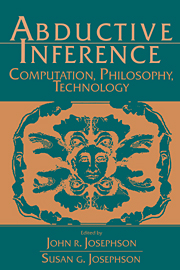Book contents
- Frontmatter
- Contents
- Contributors
- Introduction
- 1 Conceptual analysis of abduction
- 2 Knowledge-based systems and the science of AI
- 3 Two RED systems – abduction machines 1 and 2
- 4 Generalizing the control strategy – machine 3
- 5 More kinds of knowledge: Two diagnostic systems
- 6 Better task analysis, better strategy – machine 4
- 7 The computational complexity of abduction
- 8 Two more diagnostic systems
- 9 Better task definition, better strategy – machine 5
- 10 Perception and language understanding
- Appendix A Truth seekers
- Appendix B Plausibility
- Extended Bibliography
- Acknowledgments
- Index
5 - More kinds of knowledge: Two diagnostic systems
Published online by Cambridge University Press: 08 October 2009
- Frontmatter
- Contents
- Contributors
- Introduction
- 1 Conceptual analysis of abduction
- 2 Knowledge-based systems and the science of AI
- 3 Two RED systems – abduction machines 1 and 2
- 4 Generalizing the control strategy – machine 3
- 5 More kinds of knowledge: Two diagnostic systems
- 6 Better task analysis, better strategy – machine 4
- 7 The computational complexity of abduction
- 8 Two more diagnostic systems
- 9 Better task definition, better strategy – machine 5
- 10 Perception and language understanding
- Appendix A Truth seekers
- Appendix B Plausibility
- Extended Bibliography
- Acknowledgments
- Index
Summary
TIPS (Task Integrated Problem Solver) and PATHEX/LIVER were built using the PEIRCE tool. Both are examples of third-generation abduction machines. PEIRCE is not specialized for diagnoses and might be used as a shell for any abductive-assembly system. TIPS and PATHEX/LIVER, however, are diagnostic systems. They are complicated systems that are similar in organization and capabilities. Despite their similarities, in the following descriptions we emphasize TIPS's ability to dynamically integrate multiple problem-solving methods and PATHEX/LIVER's proposed ability to combine structure-function models – for causal reasoning – with compiled diagnostic knowledge. First we describe TIPS, and then PATHEX/LIVER.
TIPS
TIPS is a preliminary framework that implements the idea (described in chapter 4) of making alternative problem-solving methods available for a task. Method invocation depends on the problem state and the capabilities of the method, not on a preset sequence of invocations. TIPS presents a general mechanism for the dynamic integration of multiple methods in diagnosis.
One can describe diagnosis not only in terms of the overall goal (say, explaining symptoms in terms of malfunctions), but also in terms of the rich structure of subgoals that arise as part of diagnostic reasoning and in terms of the methods used to achieve those goals. We call such a description a task-structure analysis. A diagnostic system explicitly realized in these terms has a number of advantages:
a. Such a system has multiple approaches available for solving a problem. Thus the failure of one method does not mean failure for the whole problem solver.
b. Such a system can potentially use more kinds of knowledge.
c. Such a system can potentially solve a broader range of diagnostic problems.
- Type
- Chapter
- Information
- Abductive InferenceComputation, Philosophy, Technology, pp. 117 - 135Publisher: Cambridge University PressPrint publication year: 1994



